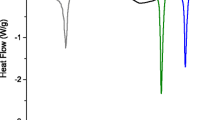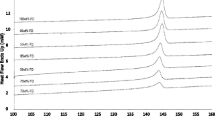Abstract
Purpose
Hot melt extrusion (HME) has demonstrated to be an adequate compounding method for poorly soluble pharmaceutical drugs, as it increases its solubility by fixing its amorphous solid-state using polymers (plasticizing) and other ingredients (non-plasticizing). However, its amorphous state of the drug and the stability of the amorphous state will greatly depend on its interactions with these (plasticizing or not).
Methods
In this study, we aimed at characterizing the impact of the combination of plasticizing (TPGS) and anti-plasticizing (PVP) ingredients in amorphous celecoxib prepared using HME in terms of chemical interactions between the components (FTIR, Raman, and NMR), viscoelasticity (loss and storage modulus), and required energy for flow (activation energy). Different celecoxib/PVP/TPGS ratios were studied to understand the synergistic effect of PVP and TPGS in inhibiting the crystallization of celecoxib when preparing amorphous dispersions using HME. We aimed at linking the viscoelastic properties of the melt with the resulting amorphous state described by the chemical interactions upon extrusion.
Results
The amorphous state of celecoxib was evidenced by strengthening of H-bonding between celecoxib and PVP, lack of characteristic crystalline peaks of celecoxib, and deshielding of aromatic protons. The melt was also characterized in terms of viscoelastic temperature dependent behavior (liquid G"; elastic G'), where increasing amounts of TPGS and PVP showed opposites effects; TPGS reduced the viscoelastic response whereas PVP increased it. Calculated melt activation energies (Ea) from the temperature dependent viscosity revealed a threshold of TPGS concentration where samples with 1% w/w of TPGS showed higher flow activation energies (higher Ea) independent of the drug/polymer ratios, compared with samples with higher amounts of TPGS.
Conclusions
Low drug content combined with anti-plasticizing (PVP) amounts and relatively low plasticizing (TPGS) amounts yields an amorphous dispersion that is characterized with strong H-bonding due to efficient mixing using HME.






Similar content being viewed by others
References
Trasi NS, Baird JA, Kestur US, Taylor LS. Factors influencing crystal growth rates from undercooled liquids of pharmaceutical compounds. J Phys Chem B. 2014;118:9974–82.
Li Y, Pang H, Guo Z, Lin L, Dong Y, Li G, et al. Interactions between drugs and polymers influencing hot melt extrusion. J Pharm Pharmacol. 2014;66:148–66.
Andrews GP, Abu-Diak O, Kusmanto F, Hornsby P, Hui Z, Jones DS. Physicochemical characterization and drug-release properties of celecoxib hot-melt extruded glass solutions. J Pharm Pharmacol. 2010;62:1580–90.
Yang F, Su Y, Zhang J, Dinunzio J, Leone A, Huang C, et al. Rheology guided rational selection of processing temperature to prepare Copovidone-Nifedipine amorphous solid dispersions via hot melt extrusion (HME). Mol Pharm. 2016;13:3494–505.
Abu-Diak OA, Jones DS, Andrews GP. An investigation into the dissolution properties of celecoxib melt extrudates: understanding the role of polymer type and concentration in stabilizing supersaturated drug concentrations. Mol Pharm. 2011;8:1362–71.
Taylor LS, Zografi G. Spectroscopic characterization of interactions between PVP and indomethacin in amorphous molecular dispersions. Pharm Res. 1997;14:1691–8.
Yani Y, Chow PS, Tan RBH. Molecular simulation study of the effect of various additives on salbutamol sulfate crystal habit. Mol Pharm. 2011;8:1910–8.
Chokshi RJ, Sandhu HK, Iyer RM, Shah NH, Malick AW, Zia H. Characterization of physico-mechanical properties of indomethacin and polymers to assess their suitability for hot-melt extrusion process as a means to manufacture solid dispersion/solution. J Pharm Sci. 2005;94:2463–74.
Gupta P, Bansal AK, Thilagavathi R, Chakraborti AK. Differential molecular interactions between the crystalline and the amorphous phases of celecoxib. J Pharm Pharmacol. 2005;57:1271–8.
Mosquera-Giraldo LI, Trasi NS, Taylor LS. Impact of surfactants on the crystal growth of amorphous celecoxib. Int J Pharm. 2014;461:251–7.
Lafountaine JS, Mcginity JW, Williams RO. Challenges and strategies in thermal processing of amorphous solid dispersions: a review. AAPS PharmSciTech. 2016;17:43–55.
Baird JA, Santiago-Quinonez D, Rinaldi C, Taylor LS. Role of viscosity in influencing the glass-forming ability of organic molecules from the undercooled melt state. Pharm Res. 2012;29:271–84.
Gupta SS, Parikh T, Meena AK, Mahajan N, Vitez I, Serajuddin ATM. Effect of carbamazepine on viscoelastic properties and hot melt extrudability of Soluplus®. Int J Pharm. 2015;478:232–9.
Yang F, Su Y, Zhu L, Brown CD, Rosen LA, Rosenberg KJ. Rheological and solid state NMR assessments of copovidone/clotrimazole model solid dispersions. Int J Pharm. 2016;500:20–31.
Hoppu P, Hietala S, Schantz S, Juppo AM. Rheology and molecular mobility of amorphous blends of citric acid and paracetamol. Eur J Pharm Biopharm. 2009;71:55–63.
Andronis V, Zografi G. Molecular mobility of supercooled amorphous indomethacin, determined by dynamic mechanical analysis. Pharm Res. 1997;14:410–4.
Messaâdi A, Dhouibi N, Hamda H, Belgacem FBM, Adbelkader YH, Ouerfelli N, and Hamzaoui AH. A new equation relating the viscosity Arrhenius temperature and the activation energy for some Newtonian classical solvents. J Chem. 2015;7–10.
Gupta P, Thilagavathi R, Chakraborti AK, Bansal AK. Role of molecular interaction in stability of celecoxib - PVP amorphous systems. Mol Pharm. 2005;3:1700–5.
Lamm MS, Dinunzio J, Khawaja NN, Crocker LS, Pecora A. Assessing mixing quality of a Copovidone-TPGS hot melt extrusion process with atomic force microscopy and differential scanning calorimetry. AAPS PharmSciTech. 2016;17:89–98.
Gupta SS, Meena A, Parikh T, and Serajuddin ATM. Investigation of thermal and viscoelastic properties of polymers relevant to hot melt extrusion - I : Polyvinylpyrrolidone and related polymers. 2014;5:32–45.
Kumar S, Radhakrishnan VK, Davis VA, Parsons DL, Babu J. Amorphous-state characterization of efavirenz-polymer hot-melt extrusion systems for dissolution enhancement. Int J Drug Dev Res. 2011;101:3456–64.
Acknowledgements
Infrastructure support was provided in part by the National Institute on Minority Health and Health Disparities RCMI Grant: 8G12MD007600. The authors thank the University of Puerto Rico (UPR) Molecular Sciences Research Building (MSRB) for providing the use of the FTIR and Raman instruments and Ramonita Ayala for assistance with these.
Author information
Authors and Affiliations
Corresponding author
Additional information
Publisher’s Note
Springer Nature remains neutral with regard to jurisdictional claims in published maps and institutional affiliations.
Rights and permissions
About this article
Cite this article
Santiago, D., Mendoza, A., Morales, Z. et al. Characterization of Amorphous Celecoxib Mixed with Plasticizing (TPGS) and Anti-plasticizing (PVP) Ingredients Using Hot Melt Extrusion. J Pharm Innov 15, 357–364 (2020). https://doi.org/10.1007/s12247-019-09377-5
Published:
Issue Date:
DOI: https://doi.org/10.1007/s12247-019-09377-5




